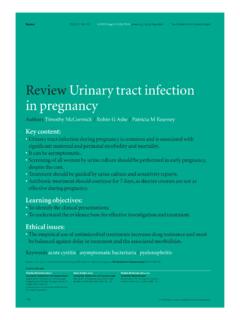Transcription of Review Thrombocytopenia in pregnancy
1 7/16/09 15:16 Page 177. The Obstetrician & Gynaecologist 2009;11:177 183 Review Review Thrombocytopenia in pregnancy Author Bethan Myers Key content: Thrombocytopenia occurs in 8 10% of all pregnancies. In pregnancy it is usually mild and benign. Rare causes can be associated with severe complications for mother and baby. Cases thought to be due to immune thrombocytopenic purpura or microangiopathic processes should be managed in a specialist centre. Learning objectives: To learn about the underlying causes. To be aware of the management of the more severe cases. To ensure appropriate referral of high-risk cases.
2 Ethical issues: Clear prepregnancy counselling is important to enable women to make informed decisions regarding future pregnancies. Women need to understand the percentage risk of recurrence of certain conditions and the risks to fetal wellbeing. Keywords HELLP syndrome / immune (idiopathic) thrombocytopenic purpura /. pre-eclampsia / thrombotic thrombocytopenic purpura Please cite this article as: Myers B. Thrombocytopenia in pregnancy . The Obstetrician & Gynaecologist 2009;11:177 183. Author details Bethan Myers MA FRCP FRCPath Consultant Haematologist Department of Haematology, Nottingham University Hospitals NHS Trust, QMC Campus, Derby Road, Nottingham NG7 2UH, UK.
3 Email: (corresponding author). 2009 Royal College of Obstetricians and Gynaecologists 177. 7/16/09 15:16 Page 178. Review 2009;11:177 183 The Obstetrician & Gynaecologist Introduction hypertensive disorders; 3 4% to an immune Platelets are involved in primary haemostasis, process;2 and the remaining 1 2% are made up of plugging sites of endothelial damage and acting as a rare constitutional thrombocytopenias, infections surface for secondary haemostasis via the coagulation and haematological The various pathway. The normal serum level of platelets in causes are listed in Box 1 and discussed in the pregnancy is 150 400 109/l.
4 Reduction of serum sections below. In general, counts that are stable platelet counts is arbitrarily considered mild if the and 100 do not require further investigation but count is 100, moderate at 50 100 and severe at 50. should be monitored. Low counts can be due to an increase in destruction or consumption of platelets, dilutional effects or Gestational Thrombocytopenia (more rarely) lack of production of platelets. (incidental Thrombocytopenia It is unusual to have any clinical signs or symptoms of pregnancy ). Box 2 shows the typical characteristics of this when the platelet count is 50,unless platelet function is also defective.
5 Common signs of Thrombocytopenia disorder, which is the most common cause of include petechiae, nose bleeding and, more rarely, Thrombocytopenia in pregnancy , occurring in haematuria and gastrointestinal bleeding. approximately 75% of cases of Thrombocytopenia and 8% of all pregnancies. It is a benign condition During pregnancy there is a general downward usually found incidentally later in pregnancy and drift in platelet count , particularly during the last there is no bleeding risk to mother or fetus. ,2 This results at term in a level that is Counts are typically 70 and usually approximately 10% less than the prepregnancy Many of the features are similar to mild immune level.
6 The mechanisms for this are thought to be a Thrombocytopenia and it can be difficult to combination of dilutional effects and acceleration of distinguish between the two disorders. There are platelet destruction across the placenta. Most women no specific diagnostic tests for either and both still have platelet counts within the normal range; conditions are diagnoses of exclusion. Rarely, however, if the starting count is at the lower end of cases of gestational Thrombocytopenia with the normal range, or there is a more severe drop, platelet counts as low as 50 have been Thrombocytopenia occurs.
7 Hence Thrombocytopenia Again, the outcome appears good. is a common finding in Most cases are mild and have no significance for mother or fetus but, The pathophysiological process is not known but in some instances, where Thrombocytopenia is part is thought to represent an acceleration of platelet of a complex clinical disorder, there can be profound consumption via an exaggeration of the and even life-threatening results for both mother and physiological process across the placenta, or baby. The effect of pregnancy on the disorder and, possibly via a mild immune process. conversely, of the disorder on the pregnancy , must be taken into account.
8 In some instances, the aetiology Gestational Thrombocytopenia resolves quickly is unique to pregnancy and the puerperium. after delivery, but it can recur in subsequent pregnancies. A count should be performed 6 weeks postnatally and the result documented. Aetiology and prevalence A platelet count below the normal range is found Management in 8 10% of Approximately 75% of For the vast majority of cases the pregnancy and these cases are due to a benign process of gestational delivery should be treated as normal. In cases of Thrombocytopenia ; 15 20% can be attributed to moderate or severe Thrombocytopenia an anaesthetic Box 1.
9 Causative diagnosis Mechanism Diagnostic features Causes of Thrombocytopenia in pregnancy Gestational Thrombocytopenia Physiological dilution, accelerated Third trimester, platelets 70 109/l;. destruction incidental finding Immune thrombocytopenic purpura Immune destruction, suppressed Diagnosis of exclusion production Thrombotic thrombocytopenic purpura, Peripheral consumption, microthrombi Unwell, fever, neurological and renal haemolytic uraemic syndrome dysfunction Haemolysis, elevated liver enzymes Peripheral consumption, microthrombi Raised LDH, ALT and bilirubin, and low platelet count syndrome haemolytic anaemia /.
10 (HELLP syndrome) pre-eclampsia, DIC. Hereditary Thrombocytopenia Bone marrow underproduction Family history, abnormal platelets Pseudothrombocytopenia Laboratory artefact platelet clumps on blood film Viral infection/drugs Multifactorial Viral illness, drugs taken, risk factors Leukaemia/lymphoma Bone marrow infiltration Abnormal blood film; enlarged liver/spleen/nodes ALT alanine aminotransferase; DIC disseminated intravascular coagulation; LDH lactate dehydrogenase 178 2009 Royal College of Obstetricians and Gynaecologists 7/16/09 15:16 Page 179. The Obstetrician & Gynaecologist 2009;11:177 183 Review consultation is useful to discuss analgesic options, 1.
